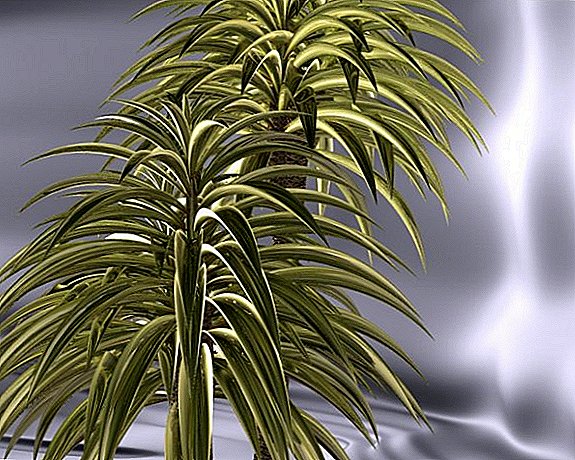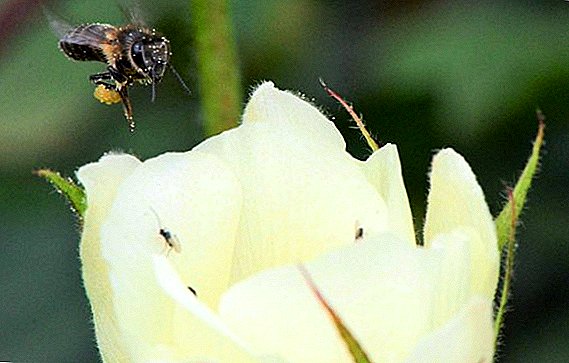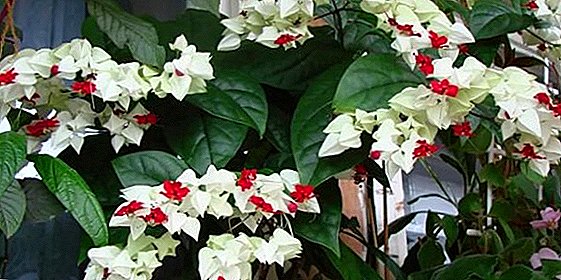 Clerodendrum, volkameria, "tree of destiny", "innocent love", "weeping heart" - all these are the names of an evergreen tropical plant that is very beautiful when grown at home. Blue, orange, white, red flowers, terry and smooth petals on the background of large bright green leaves can hardly leave anyone indifferent. Surely those who have ever seen the flowering of this plant will definitely want to have such a miracle in their home. In the article you will find tips on how to overcome the problems that may arise when growing the tree of destiny.
Clerodendrum, volkameria, "tree of destiny", "innocent love", "weeping heart" - all these are the names of an evergreen tropical plant that is very beautiful when grown at home. Blue, orange, white, red flowers, terry and smooth petals on the background of large bright green leaves can hardly leave anyone indifferent. Surely those who have ever seen the flowering of this plant will definitely want to have such a miracle in their home. In the article you will find tips on how to overcome the problems that may arise when growing the tree of destiny.
Grow a klerodendrum not so easy: it is capricious and picky - it requires the creation of natural environmental conditions for it. In addition, the plant has many enemies in the form of fungus-parasites and insect pests.
Did you know? Flower name "Clerodendrum" derived from two Greek words: "cleros" - fate and "dendrum" - tree.
How to deal with pests
Unfortunately, clerodendrum, like most indoor decorative flowering plants, does not apply to crops that are persistently immune to diseases and pests. It is often attacked by the whitefly, spider mite, aphid, shieldweed. 
White fly
Butterfly larvae whiteflies located on the underside of the leaves. They bring great harm to the plant.
Therefore, if you find that a white-winged butterfly often appears above a plant, you will most likely need to take measures to combat a dangerous insect pest. Otherwise the leaves will be warp and fall off.  Control measures. The leaflets infected with the whitefly need to be torn off and destroyed. The plant should be treated with insecticide, for example, "Aktellik", in doses indicated by the manufacturer on the package. It will take three or four sprays at intervals of three days.
Control measures. The leaflets infected with the whitefly need to be torn off and destroyed. The plant should be treated with insecticide, for example, "Aktellik", in doses indicated by the manufacturer on the package. It will take three or four sprays at intervals of three days.
Spider mite
About defeat spider mite will indicate the presence of spider webs on the stems. The leaves at the same time become sluggish, then turn yellow, dry and fall off.
Usually spider mite is bred in rooms with high temperatures and dry air.  Control measures. To prevent the appearance of an insect you need to moisten the air and the flower by spraying. When attacking a tick, it is necessary to treat the leaves with soapy water. If the infection is severe, treatment will be required. "Aktellikom".
Control measures. To prevent the appearance of an insect you need to moisten the air and the flower by spraying. When attacking a tick, it is necessary to treat the leaves with soapy water. If the infection is severe, treatment will be required. "Aktellikom".
Important! When treating houseplants with chemicals it is important to observe personal safety measures, protecting the face, hands and body with special means. Spraying should be carried out in a well ventilated area.
Aphid
Like the previous insect, aphid is a particularly dangerous sucking parasite, which is able to drink vital juices from a plant, gradually leading it to death.
With the defeat of aphids, the plant begins to lag significantly in growth, the leaves and buds become deformed, dry and fall off.  Control measures. You can also try to fight with aphids with soapy water. If folk remedies do not help, you should resort to spraying insecticide, allowed for indoor decorative flowering plants.
Control measures. You can also try to fight with aphids with soapy water. If folk remedies do not help, you should resort to spraying insecticide, allowed for indoor decorative flowering plants.
Shchitovka
The fact that the klerodendrume started up shield, will signal small yellow specks on leaflets. Gradually, they will increase in volume, then the leaves will begin to shrink and fall off.
If time does not begin to get rid of the parasite, its harmful activity can lead to the death of a flower.  Control measures. In that case, if there are not so many flail plates (you will notice them on the characteristic hard shell), then you can try to deal with them mechanically - manually by brushing with a brush. The flower is treated with a soap or soap-kerosene solution.
Control measures. In that case, if there are not so many flail plates (you will notice them on the characteristic hard shell), then you can try to deal with them mechanically - manually by brushing with a brush. The flower is treated with a soap or soap-kerosene solution.
If the scale insects attacked the bush en masse, then chemical treatments are needed. To combat this insect used "Aktellik", "Phosbecid".
Did you know? The genus "Clerodendrum" has 390 species. In the wild, it grows in the tropics of the Eastern Hemisphere in the form of shrubs, trees, lianas. Only a few species are used in room culture, most often fragrant clerodendrum (Clerodendrum fragrans), fine (Clerodendrum speciosum), Thomson (Clerodendrum thomsoniae), Philippine (Clerodendrum philippinum), paniculata (Clerodendrum paniculatum), etc.
Means to combat all kinds of difficulties in growing
In addition to parasites, a flower can affect various diseases, and its organs can dry out, fall off, become covered by burns.
All these troubles have a negative effect on the decorativeness of the plant, and in the most neglected cases lead to its doom.  What exactly it lacks for the full development, klerodendrum tell, signaling changes in appearance.
What exactly it lacks for the full development, klerodendrum tell, signaling changes in appearance.
Fungicides that will protect your plants from pests: "Tiovit Jet", "Thanos", "Oxyhom", "Ordan", "Bruenka", "Trichodermin", "Abiga-Peak", "Fundazol", "Kvadris", "Skor" , "Alirin B", "Strobe".
Clerodendrum does not bloom: how to make bloom
 One of the most common problems faced by flower growers when cultivating clerodendrum is that for some reason it does not bloom.
One of the most common problems faced by flower growers when cultivating clerodendrum is that for some reason it does not bloom.
The reasons, of course, lie in the wrong care or improperly created conditions for normal plant development.
To flower pleased annual flowering, it is necessary to hold next events:
- In winter, in the dormant period, the plant needs put in a roomwhere the temperature does not exceed + 15 ° С. This will allow the flower to gain strength, restore immunity, will also have a good impact on its development, including flowering.
- Annually from late February to early March pruning. It is necessary to cut not only dry, old branches, but also other shoots. Usually they are shortened by a third. This will stimulate new branching, and should also trigger normal flowering. The more new branches grow, the more abundant they will be covered with flowers.
- Choose a flower habitat well lighted place. The lack of light is one of the main reasons why the klerodendrum does not bloom.
Important! Best of all, the "tree of fate" grows on the windowsills facing south-west and south-east..
- Every year repot flower. Recommended time for transplant - in the autumnafter flowering. Transplanted with klerodendrum method.
- Fertilize the plant during the growing season and flowering (spring and summer). Since during these periods the flower is wasting vital forces, it should be fed with trace elements. Fertilizers such as "Agricola", "Pocon" (or others for flowering), "Emerald" are well suited for fertilizing the klerodendrum. In the fall and winter to fertilize the plant prohibited. This can cause undesirable effects.
White bloom on mealy dew leaves
Characteristic symptom of the disease powdery mildew is a white bloom on the leaves. The reason lies in the stagnant moist air and rapid temperature changes.  Spraying once a week with soda solution (5 g / 1 l of water) or fungicides: "Home", "Topaz", "Vectra" is used for treatment.
Spraying once a week with soda solution (5 g / 1 l of water) or fungicides: "Home", "Topaz", "Vectra" is used for treatment.
Yellow-brown spots on the leaves, burn leaves.
If you notice that yellow-brown spots of irregular shape began to appear on the leaves of your handsome man, it means that direct sunlight falls on them for a long time.
It is necessary either to rearrange the pot to a place where the direct rays of the sun do not penetrate, or to draw a flower from them.  The appearance of brown spots may be evidence that the plant is frozen. Check the temperature in the room, it should not drop below + 15 ° С.
The appearance of brown spots may be evidence that the plant is frozen. Check the temperature in the room, it should not drop below + 15 ° С.
Yellow leaves
When the klerodendrum leaves turn yellow, it means that it lacks moisture.
The tips of the leaves turn yellow due to improper watering. Usually such a change and simultaneous lightening of the leaves occurs when the flower is watered with hard tap water.  Control measures. The problem can be solved by using filtered or separated (for at least three days) water at a temperature for irrigation. + 25-27 ° С. In spring and summer, watering is necessary after the topsoil dries. In the autumn, it is recommended to water once or twice a week, in winter - once every two or three weeks.
Control measures. The problem can be solved by using filtered or separated (for at least three days) water at a temperature for irrigation. + 25-27 ° С. In spring and summer, watering is necessary after the topsoil dries. In the autumn, it is recommended to water once or twice a week, in winter - once every two or three weeks.
Yellow upper young leaves
Yellowing of the young leaves of the clerodendrum, drying of the upper shoots - evidence leaf chlorosis. In the future, the sheets are reduced in size, their edges twist, fall.
Did you know? Clerodendrum is among the top five room flowers that are most often prone to chlorosis.
Control measures. Prevention is especially important: it consists in the proper selection of the soil for planting, which should be light, air- and permeable. Excessively dense soil leads to the fact that the moisture in the pot stagnates, and the alkalization of the earth occurs - one of the factors that provoke chlorosis.
It is important to maintain optimum earth acidity. To do this, periodically (once a week) water the plant with acidified citric acid water.  You can help an already diseased flower with iron-containing preparations, for example, "Ferovit", "Anti-Chlorosis", "Micro-Fe", "Ferillen" and others. They are fed under the root and sprayed.
You can help an already diseased flower with iron-containing preparations, for example, "Ferovit", "Anti-Chlorosis", "Micro-Fe", "Ferillen" and others. They are fed under the root and sprayed.
Falling leaves, buds, flowers
When leaves fall in the winter time, it is not worth worrying prematurely. Perhaps this is a natural drop of foliage, which is characteristic of some species in the dormant period.
For example, Thomson's clerodendrum can completely lose the leaves for the winter. In such cases, it is necessary to observe the plant for some time.  If the leaves, buds, and flowers fall off, then perhaps the reason is low air humidity or fertilizer shortage.
If the leaves, buds, and flowers fall off, then perhaps the reason is low air humidity or fertilizer shortage.
Control measures. Clerodendrum requires compliance with its natural growing conditions, one of which is high humidity. Only in well-humidified rooms he will feel comfortable and become the most decorative.
Therefore, the flower is necessary spray regularly - in spring and summer, twice a day, in autumn - two or three times a week. In winter, this procedure is carried out not necessary.
Also in the summer once a week it is useful to arrange a shower for the plant in the bathroom. At the same time, the top of the pot should be covered with polyethylene so that water does not get into it and does not lead to excessive soil moisture. You can increase the humidity in the room in several ways:
- installing a humidifier;
- placing the pot with a flower on the tray, in which there is a layer of expanded clay or pebbles, filled with 2-3 cm of water;
- Putting next to the plant open aquarium or another container with water.
Shoots strongly drawn out
Pulling out the shoots, the plant signals that it lacks light. About the same reason may indicate the grinding of buds.  Move the flower pot to the place lit by the sun, but not under direct sunlight. Light must be diffused.
Move the flower pot to the place lit by the sun, but not under direct sunlight. Light must be diffused.
Also, shoots are drawn when the flower feels a lack of minerals. With regular feeding this problem should not be.
In your home, peperomia, havortia, dysphagia, aspidistra, fatty, juniper, fittonia will also look beautiful.If you follow all the recommendations for growing this plant, provide it with the temperature, air humidity, lighting and regular watering that it loves so much, then you most likely will not have to face the problems described above.
And klerodendrum will delight you with long flowering, beautiful emerald leaves, neat lianas and decorative elements that attract attention and enchant eyes.












